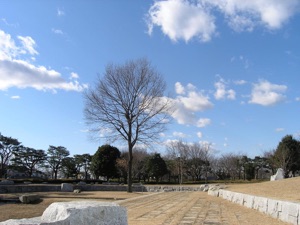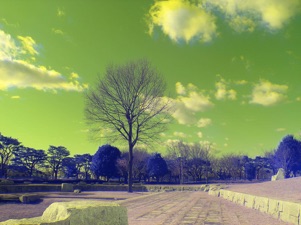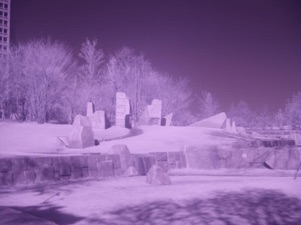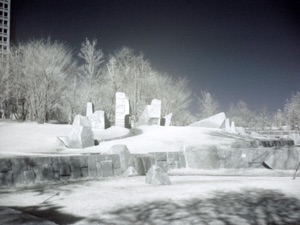Atelier Bonryu(E)
infrared photography


Atelier Bonryu(E)
infrared photography




Laboratory: Infrared Photography
False Color Infrared Photography
3-3 Finishing a False Color Infrared Photograph




Because an infrared light is not perceived by us we cannot say what kind of colorization is most appropriate for an image of the object in an infrared photograph. The most “truthful” method may be to express the infrared photograph as a monochromatic one. A monochromatic photograph is considered to express only the intensity (brightness) of the light entering the sensor of a camera. Nevertheless, even in this monochromatic photograph we can find characteristic features of an infrared photograph. Specific examples are: (1) due to the fact that an infrared light is scattered only a little by water drops in fog or haze even a distant landscape is photographed rather clearly, and (2) as there are trees of which the chlorophyll in a leaf reflects infrared light intensely and dark green leaves by the visible light shine brightly in an infrared photograph. The latter phenomenon is called “Wood’s effect” named after an American Physicist, Robert William Wood (Remark #2) who found this phenomenon about 100 years ago. Infrared photographs taken by Wood were, of course, monochromatic ones, because there were no color films at that time. Some methods to finish a monochromatic photograph from an infrared color photograph are described in Remark #6.
As described in Remark #6 we can finish a monochromatic photograph which, sufficiently, has characteristic features of an infrared photograph. However, because the wavelength range of the infrared light is very wide, the infrared light from the object contains rich information on the reflectivity of the surface of the object. Therefore, if a color is assigned to a wavelength of the infrared light appropriately a colorful, beautiful image may be reproduced on the infrared photograph. For this colorization method we consider the false color in the following.
The colorization methods for the false color are classified broadly into two categories. One is “an infrared color film type false color method” applied to two photographs, i.e., visible and infrared ones, and the other is a “false color method carried out by changing three attributes of colors in a single infrared photograph”. In the following these post-processing methods are explained.
Infrared Color Film Type False Color Method: This is the method to finish a false color infrared photograph by combining three channels selected from two photographs, i.e., a visible and an infrared ones taken at the same time by the same camera. As, usually, one channel from an infrared photograph and two channels from a visible light photograph are combined, we call this method as an infrared color film type false color method (Remark #1). If R- and G- channels’ images of the visible light photograph are selected for the combination the finished false color photograph will be very similar to an analogue infrared photograph of the same object. However, as in the case of the digital infrared photography we can choose any combination of channels of two photographs we can realize a very wide range of freedom to express colors of the image of the object. An example of a false color photograph processed by this method is shown in Figs.3-1~3-3. The concrete technique of this method is described in Remark #7.



Fig.3-1 Trees in a garden
An infrared photograph
Fig.3-2 Trees in a garden
A visible light photograph
Fig.3-3 Trees in a garden
An infrared color film type false color infrared photograph finished by combining the photographs of Fig.3-1 and Fig.3-2
False Color Infrared Photography by Adjusting Colors’ Attributes of a Single Photograph: The second category of the false color methods is carried out by adjusting three attributes of colors of a single photograph. Among these methods, especially, “false color methods to change the hue” may be the most popular and representative ones. The channel swapping method in the RGB color space and tone inversion in the CIELab (by rights, CIEL*a*b*, but for simplicity we denote it as CIELab) color space are considered to be this kind of methods. By the channel swapping to exchange the red and the blue channels the blue sky is often reproduced and for this reason the method is preferred widely.
To carry out the tone inversion in the CIELab color space one must change the working color space from the RGB color space to the CIELab color space and invert the tone distribution both in the a* and b* directions. Along the a* (b*) axis the color is changing from red (yellow) to green (blue). After the tone inversion the working color space is changed to the RGB color space and the colored image is expressed.
These processing correspond to changing a color to its opposite color or its complementary color. Especially, in the CIELab color space it is easily carried out to convert a color to its complementary color by holding the brightness (L) unchanged. It is not clearly explained why this kind of processing is appropriate as post-processing of an infrared photograph. What kind of color usage is preferable depends on the individual subjective preference and cannot be answered. However, there may be a tendency of a preferable color usage depending on the culture of the society at the time. According to my subjective opinion the processing in the CIELab color space gives more preferable color usage than the channel swapping in the RGB color space, probably because it is the color conversion between a color and a complementary color, and the CIELab color space is perceptually uniform color space.
Examples of these false color infrared photographs are shown in 3-4~3-6. The concrete techniques of these methods are described in Remark #8 (channel swapping in the RGB color space) and Remark #9 (tone inversion in the CIELab color space). Though by these methods often a false color infrared photograph is satisfactorily finished in some cases more post-processing, such as level adjustment, color balance, and so on are necessary.



Fig.3-4 Stone carving in a garden
An original infrared photograph
Fig.3-6 Stone carving in a garden
A false color infrared photograph (Tone inversion in the CIELab color space)
Fig.3-5 Stone carving in a garden
A false color infrared photograph (Channel swapping in the RGB color space: R & B)
